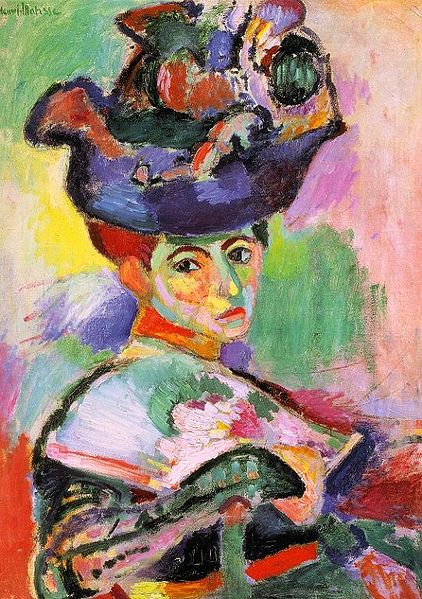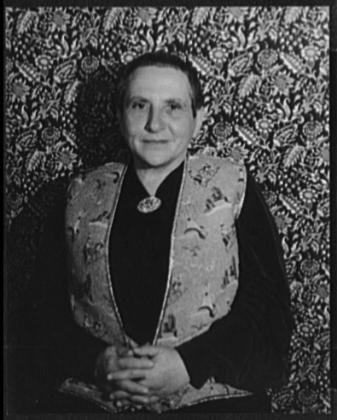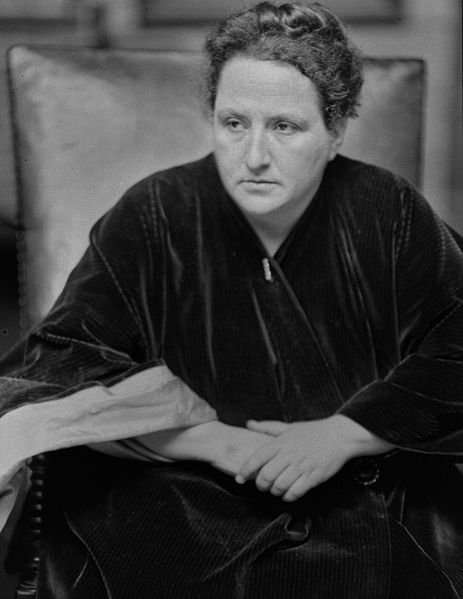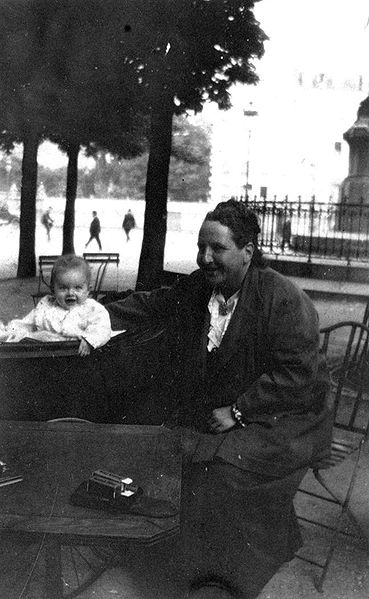<Back to Index>
- Philosopher Simone Weil, 1909
- Writer Gertrude Stein, 1874
- President of Perú and President of Bolivia Antonio José de Sucre y Alcalá, 1795
PAGE SPONSOR
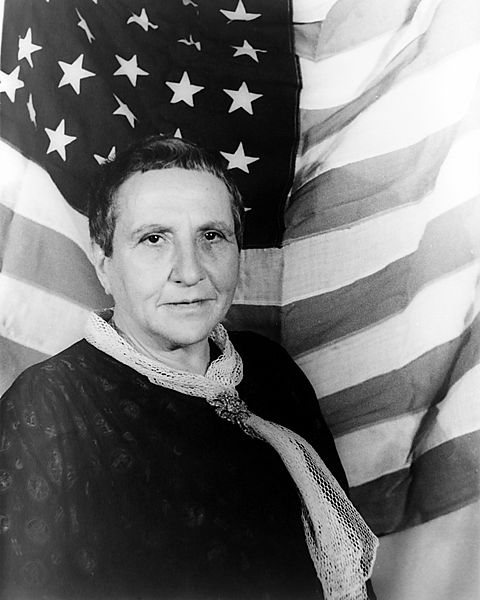
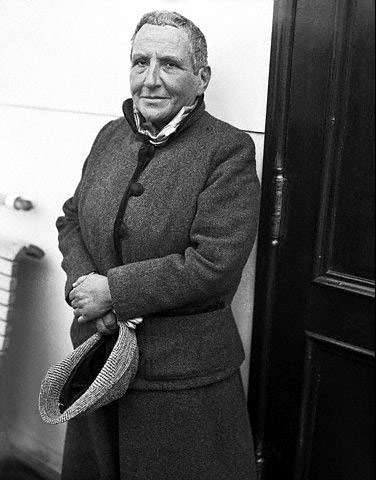
Gertrude Stein (February 3, 1874 – July 27, 1946) was an American writer and thinker who spent most of her life in France. She was well known for her writing, art collection and the many people (some of whom were, or became, famous) who visited her Paris salon.
Her adult life featured two main personal relationships. The first was her working relationship with her brother Leo Stein, from 1874 to 1914, and the second was her romantic relationship with Alice B. Toklas,
from 1907 until Stein's death in 1946. Stein shared her salon at 27 rue
de Fleurus, Paris, first with Leo and then with Alice. Throughout her
lifetime, Stein also had significant relationships with avant garde artists and literary people. She was friends with young artists Matisse and Picasso during the early 1900s, authors Thornton Wilder and Ernest Hemingway during the 1920s. She is credited with coining the term Lost Generation as description of her many expatriate acquaintances in France and Italy during the 1920s and 1930s.
Gertrude Stein, the youngest of a family of five children, was born in 1874 in Allegheny, Pennsylvania (merged with Pittsburgh in 1907), to well educated German - Jewish immigrant parents. Her father, Daniel Stein, was an executive with a railroad, whose prudent investments in streetcar lines and real estate had made the family wealthy. When Gertrude was three years old, the Steins relocated for business reasons first to Vienna and then to Paris. Her family returned to America in 1878, settling in Oakland, California, where she attended First Hebrew Congregation of Oakland's Sabbath school.
In 1888, Amelia Stein (Gertrude's mother) died, and in 1891 Daniel Stein (Gertrude's father) died. Afterward, Michael Stein (her eldest brother) managed the family business holdings, and made wise business decisions and arranged the affairs of his siblings. During most of her life, Gertrude lived on a trust income from funds her brother Michael very capably stewarded and invested.
Michael Stein arranged for Gertrude, and another sister Bertha, to live with their mother's family in Baltimore after the deaths of their parents. In 1892 she lived with her uncle David Bachrach. It was in Baltimore that Gertrude met Claribel Cone and Etta Cone who held Saturday evening salons which Gertrude would later emulate in Paris, who shared an appreciation for art and conversation about it, and who modeled a domestic division of labor that Gertrude was later to replicate in her relationship with Alice B. Toklas.
Stein attended Radcliffe College from 1893 to 1897, and was a student of psychologist William James. With James's supervision, Stein and another student named Leon Mendez Solomons performed experiments on Normal Motor Automatism, a phenomenon hypothesized to occur in people when their attention is divided between two simultaneous intelligent activities, like writing and speaking. These experiments yielded examples of writing that appeared to represent "stream of consciousness," a psychological theory often attributed to James, which became the term used to describe the style of modernist authors like Virginia Woolf and James Joyce. In 1934, behavioral psychologist, B.F. Skinner in fact interpreted Stein's notoriously difficult poem, Tender Buttons, as an example of the "normal motor automatism" Stein had written about the experiment at Radcliffe. According to a letter Stein wrote during the 1930s, however, she had never really accepted the theory of automatic writing, explaining: "there can be automatic movements, but not automatic writing. Writing for the normal person is too complicated an activity to be indulged in automatically." At Radcliffe, she began a lifelong friendship with Mabel Foote Weeks, whose correspondence traces much of the progression of Gertrude's life. In 1897, Gertrude spent the summer in Woods Hole, Massachusetts, studying embryology at the Marine Biological Laboratory, succeeded by two years at Johns Hopkins Medical School. In 1901, she left Johns Hopkins without obtaining a degree.
From 1903 to 1914 Gertrude lived in Paris with her brother Leo Stein, an art critic. It was during this period that she became well known. Much of Gertrude Stein's fame derives from a private modern art gallery she assembled, from 1904 to 1913, with her brother Leo Stein. Carl Van Vechten (music critic for the New York Times and then drama critic for the New York Press), and Henry McBride (art critic for the New York Sun), did much to increase Stein's fame in the USA. Both had wide circulation newspaper article series in which they frequently exposed Gertude's name to the public. Of the art collection at 27 Rue de Fleurus, McBride commented: "in proportion to its size and quality ... [it is] just about the most potent of any that I have ever heard of in history." McBride also made the observation that Gertrude "collected geniuses rather than masterpieces. She recognized them a long way off." The collection soon had a worldwide reputation. Leo Stein's acquaintances and study of modern art eventually resulted in the famous Stein art collections. Bernard Berenson hosted Gertrude and Leo in his English country house in 1902, and suggested they visit Paul Cézanne and Ambroise Vollard's art gallery.
The joint collection of Gertrude and Leo Stein began in late 1904, when Michael Stein announced that their trust account had accumulated a balance of 8,000 francs. They spent this at Vollard's Gallery, buying Gauguin's Sunflowers and Three Tahitians, Cézanne's Bathers, and two Renoirs. The art collection increased and the walls at Rue de Fleurus were rearranged continuously to make way for new acquisitions. In "the first half of 1905" the Steins acquired Cézanne's Portrait of Mme Cézanne and Delacroix's Perseus and Andromeda. Shortly after the opening of the Paris Autumn Salon of 1905 (on October 18, 1905), the Steins acquired Matisse's Woman with the Hat and Picasso's Young Girl with Basket of Flowers. By early 1906, Leo and Gertrude Stein's studio had many paintings by Henri Manguin, Pierre Bonnard, Pablo Picasso, Paul Cézanne, Pierre-Auguste Renoir, Honoré Daumier, Henri Matisse, and Henri de Toulouse-Lautrec. Their collection was representative of two famous art exhibitions that took place during their residence together in Paris, and to which they contributed, either by lending their art, or by patronizing the featured artists. The Steins' elder brother, Michael, and sister-in-law Sarah (Sally) acquired a large number of Henri Matisse paintings; Gertrude's friends from Baltimore, Claribel and Etta Cone, collected similarly, eventually donating their art collection, virtually intact, to the Baltimore Museum of Art.
While numerous artists visited the Stein salon, many of these artists were not represented among the paintings on the walls at 27 Rue de Fleurus. Where Renoir, Cézanne, Matisse, and Picasso's works dominated Leo and Gertrude's collection, Sarah Stein's collection emphasized on Matisse. Contemporaries of Leo and Gertrude, Matisse and Picasso became part of their social circle, and were a part of the early Saturday evenings at 27 Rue de Fleurus. Gertrude attributed the beginnings of the Saturday evening salons to Matisse, as
| “ | [m]ore and more frequently, people began visiting to see the Matisse paintings -- and the Cézannes: "Matisse brought people, everybody brought somebody, and they came at any time and it began to be a nuisance, and it was in this way that Saturday evenings began." | ” |
Among Picasso's acquaintances who frequented the Saturday evenings were: Fernande Olivier (Picasso's mistress), Georges Braque (artist), André Derain (artist), Max Jacob (poet), Guillaume Apollinaire (poet), Marie Laurencin (Apollinaire's mistress and an artist in her own right), Henri Rousseau (painter), and Joseph Stella.
In April 1914, when Leo relocated to Settignano, Italy, near Florence, and the art collection was divided. The division of their art collection was described in a letter by Leo, by which he stated:
| “ | The Cézanne apples have a unique importance to me that nothing can replace. The Picasso landscape is not important in any such sense. We are, as it seems to me on the whole, both so well off now that we needn't repine. The Cézanne's had to be divided. I am willing to leave you the Picasso oeuvre, as you left me the Renoir, and you can have everything except that. I want to keep the few drawings that I have. This leaves no string for me, it is financially equable either way for estimates are only rough & ready methods, & I'm afraid you'll have to look upon the loss of the apples as an act of God. I have been anxious above all things that each should have in reason all that he wanted, and just as I was glad that Renoir was sufficiently indifferent to you so that you were ready to give them up, so I am glad that Pablo is sufficiently indifferent to me that I am willing to let you have all you want of it. | ” |
The Steins' holdings were dispersed eventually, by various methods and for various reasons.
After Stein's and Leo's households separated in 1914, she continued to collect examples of Picasso's art which had turned to Cubism. At her death, Gertrude's remaining collection emphasized the artwork of Picasso and Juan Gris, having sold most of her other pictures.
While living in Paris, Gertrude began writing for publication. Her earliest writings were mainly retellings of her college experiences. Her first critically acclaimed publication was "Three Lives."
In 1911 Mildred Aldrich introduced Gertrude to Mabel Dodge Luhan and they began a short lived but fruitful friendship during which a wealthy Mabel Dodge promoted Gertrude's legend in the United States. Mabel was enthusiastic about Gertrude's sprawling publication The Makings of Americans and, at a time when Gertrude had much difficulty selling her writing to publishers, privately published 300 copies of Portrait of Mabel Dodge at Villa Curonia, a copy of which was valued at $25,000 in 2007. Dodge was also involved in the publicity and planning of the 69th Armory Show in 1913, "the first avant - garde art exhibition in America." In addition, she wrote the first critical analysis of Gertrude's writing to appear in America, in "Speculations, or Post-Impressionists in Prose", published in a special March 1913 publication of Arts and Decoration. Foreshadowing Gertrude's later critical reception, Mabel wrote in "Speculations":
| “ | In Gertrude Stein's writing every word lives and, apart from concept, it is so exquisitely rhythmical and cadenced that if we read it aloud and receive it as pure sound, it is like a kind of sensuous music. Just as one may stop, for once, in a way, before a canvas of Picasso, and, letting one's reason sleep for an instant, may exclaim: "It is a fine pattern!" so, listening to Gertrude Steins' words and forgetting to try to understand what they mean, one submits to their gradual charm. | ” |
Mabel attributed the end of their friendship to an exchange in the autumn of 1912 when, during lunch, Gertrude sent her "such a good strong look over the table that it seemed to cut across the air to me in a band of electrified steel -- a smile traveling across on it -- powerful -- Heavens!" Alice interpreted the look as a flirtation and left the room, prompting Gertrude to follow, and when Gertrude returned, she said, "[Alice] doesn't want to come lunch ... She feels the heat today." The salon, and the people that came to visit it, provided the inspiration for The Autobiography of Alice B. Toklas.
Gertrude completed Q.E.D. (Quod Erat Demonstrandum) on October 24, 1903.
In 1904 Stein began Fernhurst, a fictional account of a scandalous three person romantic affair involving a dean (M. Carey Thomas) and a faculty member (Mary Gwinn) from Bryn Mawr College and a Harvard graduate (Alfred Hodder). Mellow asserts that Fernhurst "is a decidedly minor and awkward piece of writing." It includes some commentary that Gertrude mentioned in her autobiography when she discussed the "fateful twenty-ninth year" during which:
| “ | all
the forces that have been engaged through the years of childhood,
adolescence and youth in confused and ferocious combat range themselves
in ordered ranks (and during which) the straight and narrow gateway of
maturity, and life which was all uproar and confusion narrows down to
form and purpose, and we exchange a great dim possibility for a small
hard reality. Also in our American life where there is no coercion in custom and it is our right to change our vocation so often as we have desire and opportunity, it is a common experience that our youth extends through the whole first twenty-nine years of our life and it is not till we reach thirty that we find at last that vocation for which we feel ourselves fit and to which we willingly devote continued labor. | ” |
Mellow observes that, in 1904, 30-year-old Gertrude "had evidently determined that the 'small hard reality' of her life would be writing".
Among the paintings was a portrait of Madame Cézanne which provided Gertrude with inspiration as she began to write, and which she credited with her evolving writing style illustrated by her early work, Three Lives:
| “ | Gertrude claimed that the stylistic method of (Three Lives) had been influenced by the Cézanne portrait under which she sat writing. The portrait of Madame Cézanne is one of the monumental examples of the artist's method, each exacting, carefully negotiated plane -- from the suave reds of the armchair and the gray blues of the sitter's jacket to the vaguely figured wallpaper of the background -- having been structured into existence, seeming to fix the subject for all eternity. So it was with Gertrude's repetitive sentences, each one building up, phrase by phrase, the substance of her characters. | ” |
She began her novel Three Lives during the spring of 1905, and finished it the following year.
Gertrude Stein stated the date for her writing of The Making of Americans was 1906 - 1908. Her biographer has uncovered evidence that it actually began in 1902 and did not end until 1911. Stein compared her work to James Joyce's Ulysses and to Marcel Proust's In Search of Lost Time. Her critics were less enthusiastic about it.
Gertrude's Matisse and Picasso descriptive essays appeared in Alfred Stieglitz's August 1912 edition of Camera Work, a special edition devoted to Picasso and Matisse, and represented her very first publication. Of this publication, Gertrude said, "[h]e was the first one that ever printed anything that I had done. And you can imagine what that meant to me or to any one."
Gertrude's descriptive essays apparently began with her essay of Alice B. Toklas, "a little prose vignette, a kind of happy inspiration that had detached itself from the torrential prose of The Making of Americans". Gertrude's early efforts at word portraits are catalogued in Mellow, 1974, and under individual's names in Kellner, 1988. Matisse and Picasso were subjects of early essays, later collected and published in Geography and Plays (published 1922) and Portraits and Prayers (published 1934). The Matisse and Picasso portraits were reprinted in MoMA, 1970, pp. 99–102. Her subjects included several ultimately famous personages, and her subjects provided a description of what she observed in her Saturday salons at 27 Rue de Fleurus: "Ada" (Alice B. Toklas), "Two Women" (The Cone Sisters) (Claribel Cone and Etta Cone), Miss Furr and Miss Skeene (Ethel Mars and Maud Hunt Squire), "Men" (Hutchins Hapgood, Peter David Edstrom, Maurice Sterne), "Matisse" (1909) (Henri Matisse), "Picasso" (1909) (Pablo Picasso), "Portrait of Mabel Dodge at the Villa Curonia" (1911) (Mabel Dodge Luhan), and "Guillaume Apollinaire" (1913).
Tender Buttons is the best known of Gertrude Stein's "hermetic" works. It is a small book separated into three sections - Food, Objects and Rooms each containing prose under subtitles. Its publication in 1914 caused a great dispute between Mabel Dodge Luhan and Gertrude, because Mabel had been working to have it published by another publisher. Mabel wrote at length about the bad choice of publishing it with the press Gertrude selected. Evans wrote Gertrude:
Claire Marie Press ... is absolutely third rate, & in bad odor here, being called for the most part 'decadent" and Broadwayish and that sort of thing. . . . I think it would be a pity to publish with [Claire Marie Press] if it will emphasize the idea in the opinion of the public, that there is something degenerate & effete & decadent about the whole of the cubist movement which they all connect you with, because, hang it all, as long as they don't understand a thing they think all sorts of things. My feeling in this is quite strong.
Stein ignored Mabel's exhortations, and eventually Mabel, and published 1,000 copies of the book, in 1914. (An antiquarian copy was valued at over $1,200 in 2007). It is currently in print.
Stein's poems in Tender Buttons are very stylised and hermetic, as she preferred for sound rather than sense.
Stein met her long time romantic partner, Alice B. Toklas on September 8, 1907 on Toklas's first day in Paris, at Sarah and Michael Stein's apartment. On meeting Stein, Toklas wrote:
| “ | She was a golden brown presence, burned by the Tuscan sun and with a golden glint in her warm brown hair. She was dressed in a warm brown corduroy suit. She wore a large round coral brooch and when she talked, very little, or laughed, a good deal, I thought her voice came from this brooch. It was unlike anyone else's voice -- deep, full, velvety, like a great contralto's, like two voices. | ” |
Soon thereafter, Stein introduced Toklas to Pablo Picasso at his studio, where he was at work on Les Demoiselles d'Avignon. Les Demoiselles d'Avignon was a painting that "marked the beginning of the end of Leo's support for Picasso."
In 1908, they summered in Fiesole, Italy, Toklas staying with Harriet Lane Levy, the companion of her trip from the United States, and her housemate until Alice relocated in with Stein and Leo in 1910. That summer, Stein stayed with Michael and Sarah Stein, their son Allan, and Leo in a nearby villa. Gertrude and Alice's summer of 1908 is memorialized in images of the two of them in Venice, at the piazza in front of Saint Mark's.
Toklas arrived in 1907 with Harriet Levy, with Toklas maintaining living arrangements with Levy until she moved to 27 Rue de Fleurus in 1910. In an essay written at the time, Stein discussed the complex efforts humorously, involving much letter writing and Victorian niceties, to extricate Levy from Toklas' living arrangements. In "Harriet", Stein considers Levy's nonexistent plans for the summer, following her nonexistent plans for the winter:
| “ | She said she did not have any plans for the summer. No one was interested in this thing in whether she had any plans for the summer. That is not the complete history of this thing, some were interested in this thing in her not having any plans for the summer..... Some who were not interested in her not having made plans for the summer were interested in her not having made plans for the following winter. She had not made plans for the summer and she had not made plans for the following winter.... There was then coming to be the end of the summer and she was then not answering anything when any one asked her what were her plans for the winter. | ” |
Stein and Toklas had plans to visit England to sign a contract for the publication of Three Lives, to spend a few weeks, and journey then to Spain. They left Paris on July 6, 1914 and returned on October 17. When Britain declared war on Germany, Stein and Toklas were visiting Alfred North Whitehead in England. After a supposed three week trip to England that endured for three months due to the War, they returned to France, where they spent the first winter of the war.
With money acquired from the sale of Stein's last Matisse Woman with a Hat to her brother Michael, she and Toklas vacationed in Spain from May 1915, through the spring of 1916. During their interlude in Majorca, Spain, Gertrude continued her correspondence with Mildred Aldrich who kept her apprised of the War's progression, and eventually inspired Gertrude and Alice to return to France to join the war effort.
Toklas and Stein returned to Paris in June 1916 and acquired a Ford with the help of associates in the United States; Gertrude learned to drive it with the help of her friend William Edwards Cook. Gertrude and Alice then volunteered to drive supplies to French hospitals, in the Ford they named Auntie, "after Gertrude's aunt Pauline, 'who always behaved admirably in emergencies and behaved fairly well most times if she was flattered.'"
During the 1920s, her salon at 27 Rue de Fleurus, with walls covered by avant - garde paintings, attracted many of the great writers of the time, including Ernest Hemingway, Ezra Pound, Thornton Wilder, and Sherwood Anderson. While she has been credited with inventing the term "Lost Generation" for some of these expatriate American writers, at least three versions of the story that led to the phrase are on record, two by Ernest Hemingway and one by Gertrude Stein. During the 1920s, she became friends with writer Mina Loy,
and the two would remain lifelong friends. Extremely charming,
eloquent, and cheerful, she had many friends and promoted herself
often. Her judgments of literature and art were influential. She was
Ernest Hemingway's mentor, and upon the birth of his son he asked her
to be the godmother of his child. During the summer of 1931, Stein
advised the young composer and writer Paul Bowles to go to Tangier, where she and Alice had vacationed.
During the 1930s, Stein and Toklas became famous with the 1933 mass market publication of The Autobiography of Alice B. Toklas. She and Alice had an extended lecture tour in the United States during this decade. They also spent several summers in Bilignin, France, and doted on a famous poodle named "Basket" whose successor, "Basket II", comforted Alice in the years after Gertrude's death.
With
the outbreak of World War II, Stein and Toklas relocated to a country
home that they had rented for many years previously in Bilignin, Ain, in the Rhône - Alpes region. Gertrude and Alice, who were both Jewish, escaped persecution probably because of their friendship to Bernard Faÿ who was a collaborator with the Vichy regime and had connections to the Gestapo.
When Faÿ was sentenced to hard labor for life after the war,
Gertrude and Alice campaigned for his release. Several years later,
Toklas would contribute money to Faÿ's escape from prison. After
the war, Stein was visited by many young American soldiers.
Her preface written for a 1945 Paris exhibition for Spanish painter Francisco Riba - Rovira "is one of Gertrude Stein's last texts" on her vision of the painting art, approximately one year before her death. In it she expressed her opinions of Picasso, Cézanne, Matisse and Juan Gris as well as Riba - Rovira, a familiar artist of her salon at rue de Fleurus.
Stein died at the age of 72 from stomach cancer in Neuilly-sur-Seine on July 27, 1946, and was interred in Paris in the Père Lachaise cemetery.
In one account by Toklas, when Stein was being wheeled into the operating room for surgery on her stomach, she asked Toklas, "What is the answer?" When Toklas did not answer, Stein said, "In that case, what is the question?"
Stein named writer and photographer Carl Van Vechten as her literary executor,
and he helped to publish works of hers which remained unpublished at
the time of her death. There is a monument to Stein on the Upper
Terrace of Bryant Park, New York.
Stein is the author of one of the earliest coming out stories, Q.E.D. (published in 1950 as Things as They Are), written in 1903 and suppressed by the author. The story, written during travels after ending college, is based on a three-person romantic affair she joined while studying at Johns Hopkins in Baltimore. The affair was complicated, as Stein was less experienced with the social dynamics of romantic friendship as well as her own sexuality and any moral dilemmas regarding it. Stein maintained at the time that she detested "passion in its many disguised forms". The relationships of Stein's acquaintances Mabel Haynes and Grace Lounsbury ended as Haynes started one with Mary Bookstaver (also known as May Bookstaver). Stein became enamored of Bookstaver but was unsuccessful in advancing their relationship. Bookstaver, Haynes, and Lounsbury all later married men.
Her growing awareness of her sexuality began to interfere with the bourgeois values implicit in her medical studies and would have put her at odds with contemporary feminist theory and opinion, and Q.E.D. may have assisted her with understanding her scholarly and romantic failure. However, Stein began to accept and define her pseudo-masculinity through the ideas of Otto Weininger's Sex and Character (1906). Weininger, though Jewish by birth, considered Jewish men effeminate and women as incapable of selfhood and genius, except for female homosexuals who may approximate masculinity.
More positive affirmations of Stein's sexuality began with her relationship with Toklas. Ernest Hemingway describes how Alice was Gertrude's "wife" in that Stein rarely addressed his (Hemingway's) wife, and he treated Alice the same, leaving the two "wives" to chat. Alice was 4'11" tall, and Gertrude was 5'1".
The more affirming essay "Miss Furr and Miss Skeene" is one of the first homosexual revelation stories to be published. The work, like Q.E.D., is informed by Stein's growing involvement with a homosexual community, though it is based on lesbian partners Maud Hunt Squire and Ethel Mars. The work contains the word "gay" over one hundred times, perhaps the first published use of the word "gay" in reference to same-sex relationships and those who have them, and, as such, uninformed readers missed the lesbian content. A similar essay of homosexual men begins more obviously with the line "Sometimes men are kissing" but is less well known.
In Tender Buttons Stein
comments on lesbian sexuality and the work abounds with "highly
condensed layers of public and private meanings" created by wordplay
including puns on the words "box", "cow", and in titles such as "tender
buttons".
Stein was politically conservative, though the nature of her opinions is debated. According to Janet Malcolm's Two Lives: Gertrude and Alice, Stein was a life long Republican and vocal critic of Franklin Delano Roosevelt and the New Deal. She publicly endorsed Franco during the Spanish Civil War and admired Vichy leader Maréchal Pétain,
translating some of the latter's speeches into English. These
unpublished translations included a favorable introduction in which she
compared him to George Washington. Some have
argued for a more nuanced view of Stein's collaborationist activity,
arguing that it was rooted in her wartime predicament and status as a
Jew in Nazi - occupied France. Prior to World War II she made public her opinion that Adolf Hitler should be awarded the Nobel Peace Prize.
"I say that Hitler ought to have the peace prize, because he is
removing all the elements of contest and of struggle from Germany. By
driving out the Jews and the democratic and Left element, he is driving
out everything that conduces to activity. That means peace ... By
suppressing Jews ... he was ending struggle in Germany" (New York Times
Magazine, May 6, 1934). Stein
was later to comment on Hitler, Mussolini, and Roosevelt: "There is too
much fathering going on just now and there is no doubt about it fathers
are depressing".
